Curriculum
A typical class at Two Rivers Martial Arts consists of the following activities: kicking, blocking, and striking drills, forms, sparring, and board breaking.
Kicking Drills
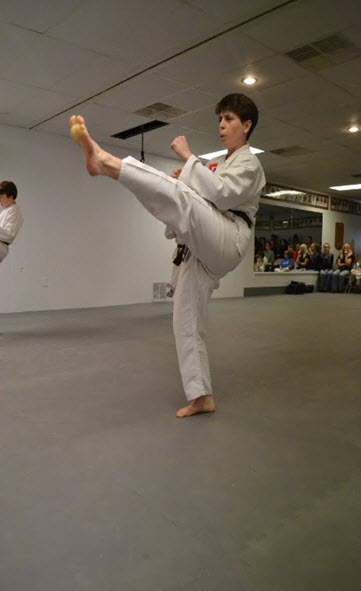
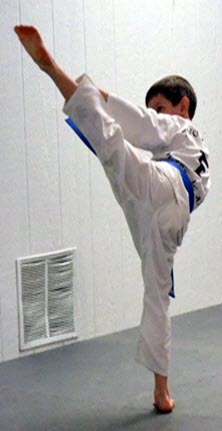
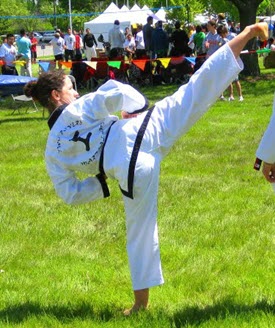
There are three basic kicks we practice every class: front snap kick,
roundhouse kick, and side kick. We practice these techniques
repeatedly and at all levels of experience because they are the foundation of the
"Tae" in Tae Kwon Do. As students advance in rank, they learn variations of these
three kicks. They also learn different types of kicks that are related to them, but
these three remain the core from white belt to black belt.
Other kicking drills include combination kicking and jump kicking. In combination
kicking, students perform two or more kicks in a row towards an imaginary opponent.
The level of difficulty increases as the students level of experience increases.
While a white belt might perform a front kick followed by a side kick, a black belt
might be doing a double roundhouse kick followed by a jump reverse hooking kick.
In jump kicking drills students begin with their feet together on the ground and
then jump up and perform a kick while in the air. Students usually practice these
kicks with a partner so that they have a target to aim at. At white belt level the
kick would be a middle jump front snap kick. At black belt level it might be a jump
hooking kick, a tornado kick, or a high jump front snap kick with both feet at the
same time.
Blocking and Striking Drills
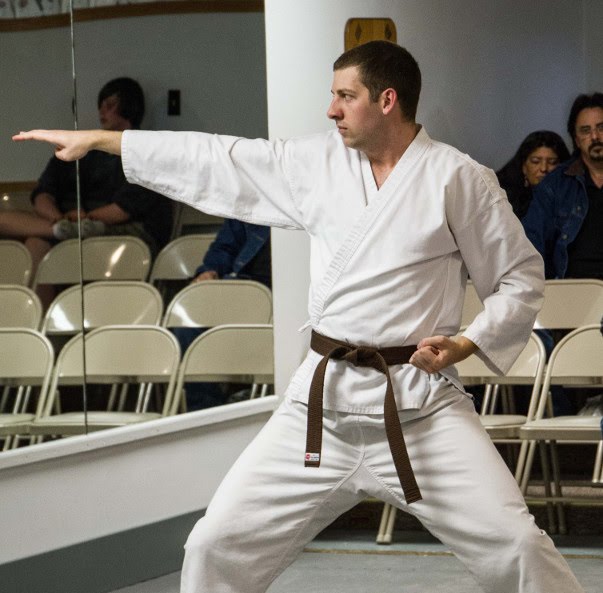
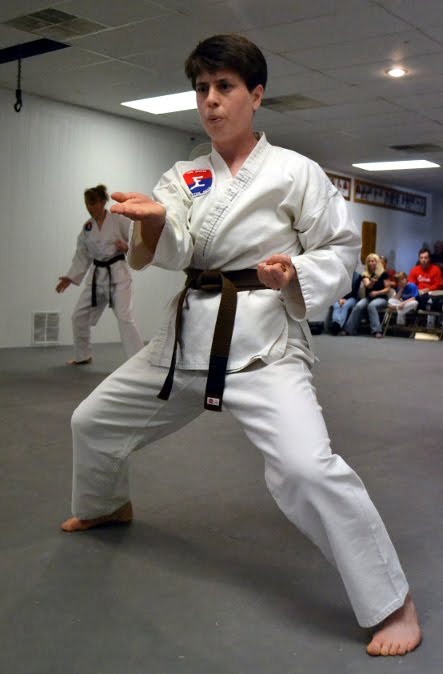
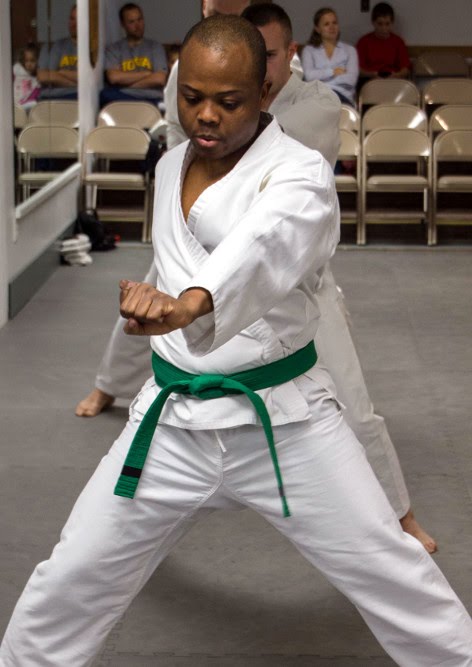
There are ten basic techniques students learn as white belts
and continue to practice as they advance. They are low block,
high block, middle punch, high punch, inside-outside block, outside-inside block,
knife-hand block low, knife-hand block middle, two-finger strike high, and reverse
elbow strike high. As students advance in rank and level of experience, they learn
other hand techniques for blocking and counter-attacking.
Forms
 A form, or Hyung, is a battle between the student performing the form and four or
more imaginary opponents. Hyungs were created by Tae Kwon Do masters in the past
and are an important tradition in this martial art.
A form, or Hyung, is a battle between the student performing the form and four or
more imaginary opponents. Hyungs were created by Tae Kwon Do masters in the past
and are an important tradition in this martial art.
Each form is a series of blocks, kicks, punches, and other strikes performed towards
those imaginary opponents. They provide students with the opportunity to learn and
practice new techniques, and to correct and improve old techniques. Forms are also
an excellent way to warm up before class.
At Two Rivers Martial Arts we practice both the ITF (International Tae Kwon Do Federation)
forms and the WTF (World Tae Kwon Do Federation) Pal-Gwe forms. At each belt level,
students learn one or two forms which they must be able to perform in a satisfactory
manner when they test to advance to the next rank.
For more details on the forms, check out the
student resources section.
Sparring
At Two Rivers Martial Arts, there are two distinct types of
sparring that we practice: One-Step Sparring and Free Sparring.
One-Step Sparring
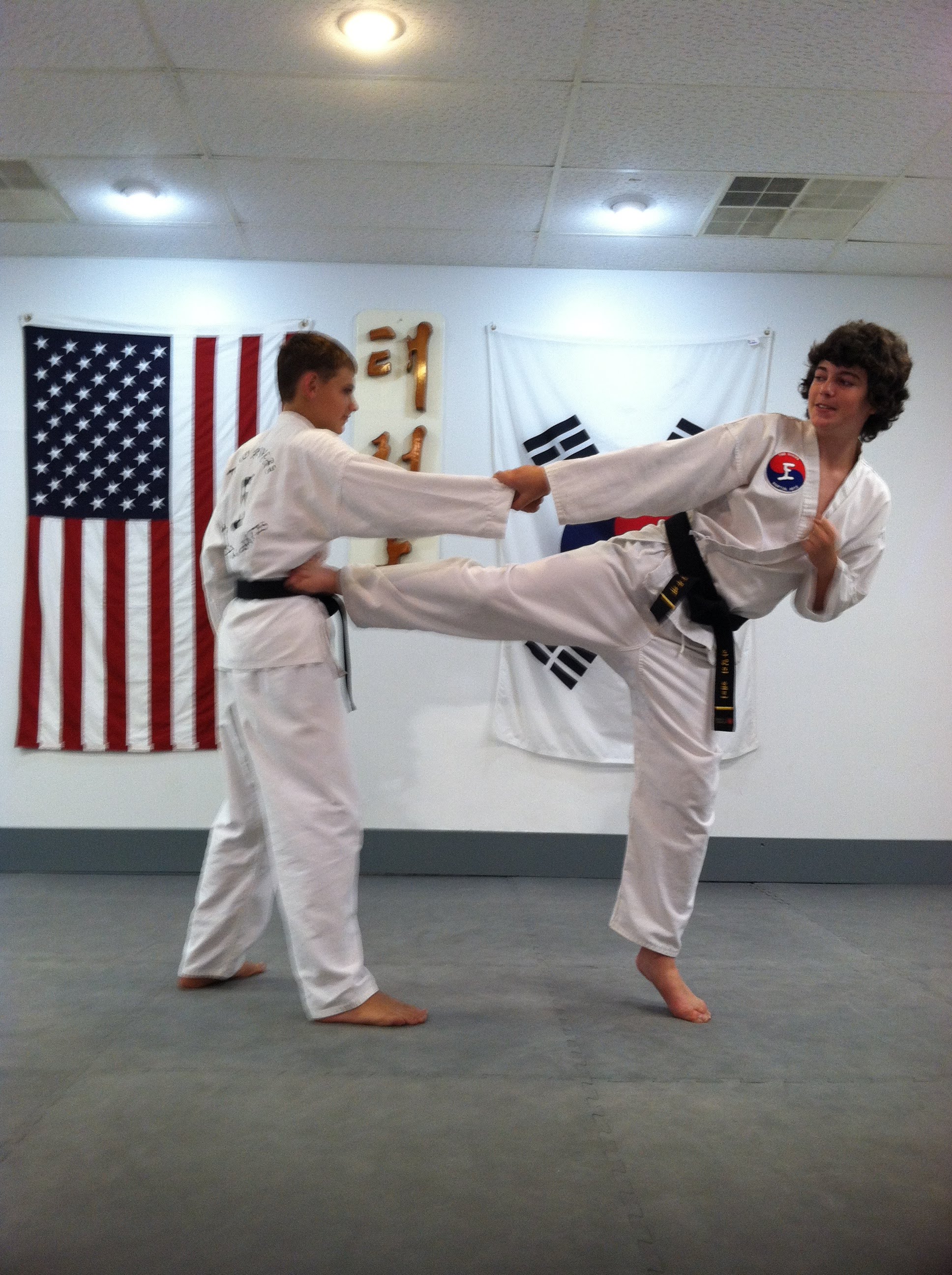 One-step sparring is a
system for practicing self-defense techniques.
In this system,
students work in pairs and take turns being the
attacker and the defender. The attacker
always performs a low block and yells to
indicate they are about to attack. The defender
stands in a horse stance and yells back indicating
that they are ready to defend.
After the defender has yelled, the attacker steps
forward and throws a high section
punch. The defender reacts by evading or blocking
the attack and counter-attacking
immediately. There are seven different techniques
that students practice for each
color belt (white, yellow, orange, green, blue,
brown). By the time students are
ready to test for their black belts they will have
learned, and must be able to perform,
at least 42 different one-step sparring techniques.
Black belts create their own
one-step techniques in addition to practicing nine
techniques created by Master Heintz.
One-step sparring is a
system for practicing self-defense techniques.
In this system,
students work in pairs and take turns being the
attacker and the defender. The attacker
always performs a low block and yells to
indicate they are about to attack. The defender
stands in a horse stance and yells back indicating
that they are ready to defend.
After the defender has yelled, the attacker steps
forward and throws a high section
punch. The defender reacts by evading or blocking
the attack and counter-attacking
immediately. There are seven different techniques
that students practice for each
color belt (white, yellow, orange, green, blue,
brown). By the time students are
ready to test for their black belts they will have
learned, and must be able to perform,
at least 42 different one-step sparring techniques.
Black belts create their own
one-step techniques in addition to practicing nine
techniques created by Master Heintz.
Free Sparring
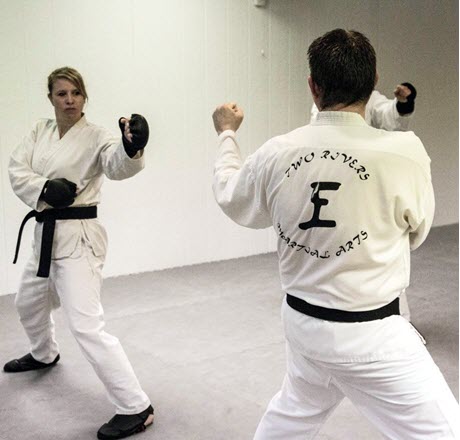
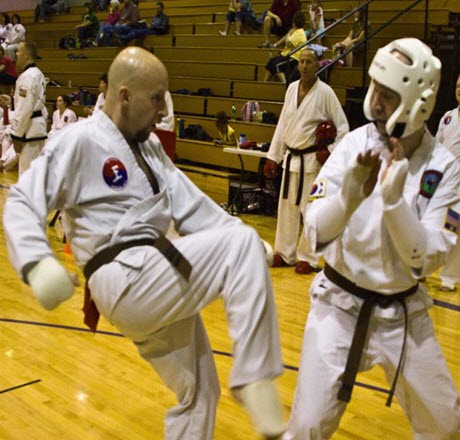
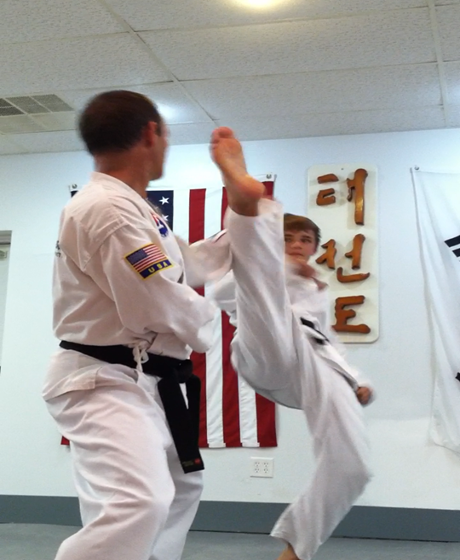
Free sparring is the closest we come to actual combat in class and is therefore a
very important part of this martial art.
It is performed in pairs, or sometimes with two or three students against one student.
"Free" does not mean students may do anything they want to their partner. All strikes
must be above the belt and to the front of your partner's body. "Free" means that
students don't take turns on offense and defense. In fact if you catch your partner
off guard, you should press your advantage striking as many open and legal targets
as possible before they regain their composure.
For safety reasons we practice no-contact free sparring during regular classes.
This means that students are to kick and punch towards open targets on their partner,
but should stop their techniques at least one centimeter before actually making contact.
In general, the higher the level of experience, the harder students wish to free
spar. When two black belts free spar, there is frequently light contact, but even
then they must avoid following through with their techniques so as to avoid serious
injuries. The golden rule for free sparring in class is not to go harder than the
person across from you is comfortable with.
Board Breaking
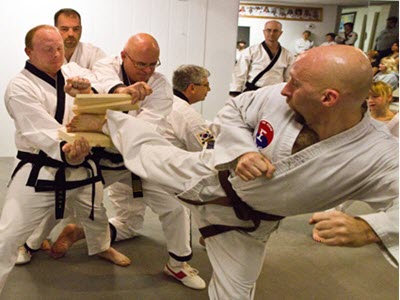
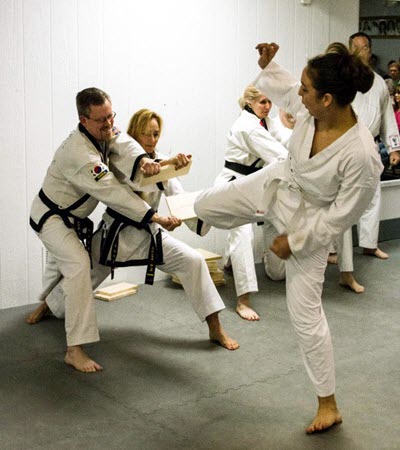
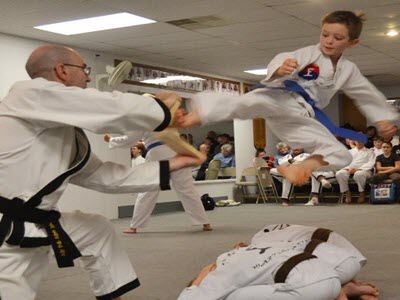
The purpose of board breaking is to build self-confidence, increase accuracy,
and to show the effectiveness of your strikes.
Four of the keys to successful board breaking are relaxation, accuracy, follow through,
and perseverance. If you are tense when you attempt a board break, then opposing
muscle groups will contract at the same time. When this happens, both your speed
and accuracy will be limited. If you are not accurate, you will miss the center of
the boards and they will not break. If you do not follow through, then the impact
of your strike will be absorbed by your body causing damage to your hand or foot
instead of breaking the boards. If you do not persevere, then you lose the opportunity
to learn from your mistakes.
The solution to all of these potential problems is lots of practice and a strong
kihap (yell). Repetition of the same technique builds your confidence in its application
and increases your accuracy. As your confidence increases through practice, you are
better able to relax when attempting a board break. A strong kihap right before you
strike eases your tension, increases your confidence, and helps you to follow through.
There's nothing quite the same as the sense of strength and confidence you gain
when you finally do master a difficult board breaking technique. That feeling is
well worth the time required to become a good board breaker.
Self Defense
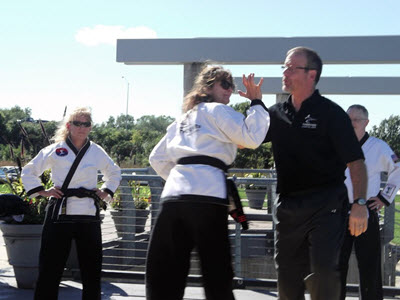 Two Rivers Martial Arts Self Defense curriculum was created by Master Brad Deaton with
contributions by Master Steven Gonzalez and Mr. Lance Kinseth. The initial idea was to
develop additional strategies for our young students to be able to diffuse a threatening
situation in the public schools without using force. The program was design to handle
any size and shape of attacker and practitioner, neither age nor gender should matter.
Development of the program resulted in basic escapes from an attacker's hold at the Yellow,
Orange and Green rankings allowing the defender to be able to move away from the threat.
Bringing the attacker into a controlled situation was the result at the Blue, Brown 3rd
Gup Permanent and Brown 2nd Gup Permanent rankings. At the Brown 1st Gup Permanent ranking,
the attacker is moved into a controlled take-down or throw. Also developed was a Trap/Escape
situation at each ranking of which typically happens to children on the playground being
held against a wall or on the ground with someone on top of them as an example. This
curriculum is also administered to the adults of our school.
Two Rivers Martial Arts Self Defense curriculum was created by Master Brad Deaton with
contributions by Master Steven Gonzalez and Mr. Lance Kinseth. The initial idea was to
develop additional strategies for our young students to be able to diffuse a threatening
situation in the public schools without using force. The program was design to handle
any size and shape of attacker and practitioner, neither age nor gender should matter.
Development of the program resulted in basic escapes from an attacker's hold at the Yellow,
Orange and Green rankings allowing the defender to be able to move away from the threat.
Bringing the attacker into a controlled situation was the result at the Blue, Brown 3rd
Gup Permanent and Brown 2nd Gup Permanent rankings. At the Brown 1st Gup Permanent ranking,
the attacker is moved into a controlled take-down or throw. Also developed was a Trap/Escape
situation at each ranking of which typically happens to children on the playground being
held against a wall or on the ground with someone on top of them as an example. This
curriculum is also administered to the adults of our school.
Advancement from 1st Gup Permanent to Temporary Black Belt
By the time you reach the rank of 1st Gup Permanent, you should be aware that
the testing procedure for achieving Temporary
Black Belt rank has several steps and a number of requirements that must be met. Your
instructor will supply you with a "Brown Belt Letter" that gives the outline for this
process. Tests for Temporary Black Belt are held each April, August and December. To
test, you will need to go before a testing committee three times, monthly, leading up
to the test. For example, the committee will meet in January,
February and March to evaluate
students for the April test. These committee checks are designed to help insure you have
a successful black belt test.